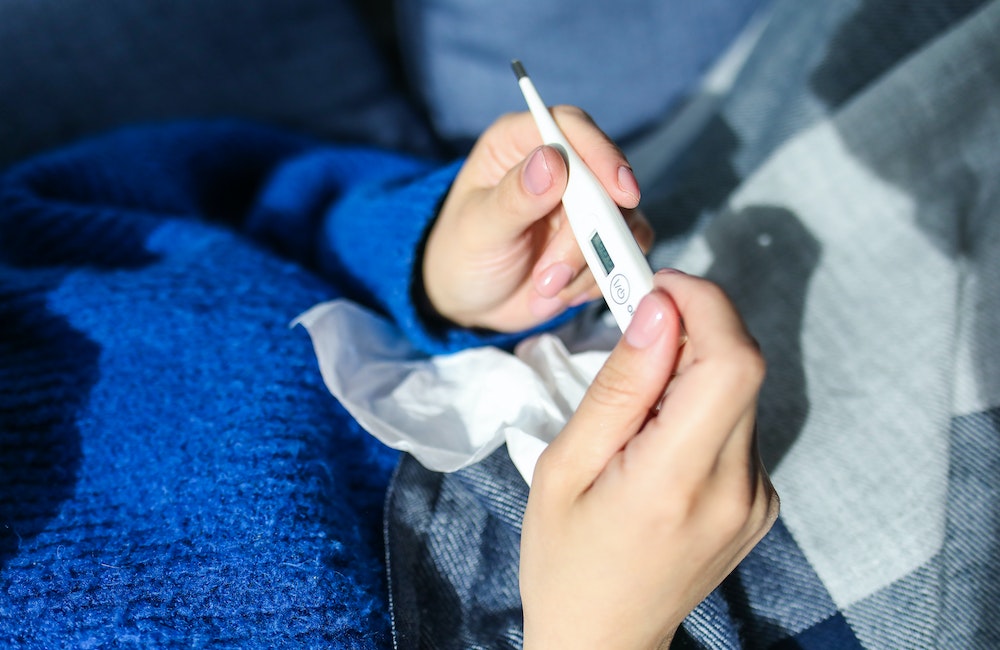Typhoid fever is a part of enteric fever, (a collective term for both typhoid and paratyphoid fevers). Paratyphoid is clinically indistinct from typhoid fever, thus enteric and typhoid fevers are used mutually. It is a multisystem illness that is a public health concern, especially in the developing world.
Other serotypes, Salmonella paratyphi (A, B, C), also cause similar syndromes but with less clinically significant disease.
Typhoid fever is one of the major causes of mortality and morbidity in overcrowded and unhygienic areas. Though, comprehensive research and public health interventions have decreased the occurrence.
What is Typhoid Fever?
Typhoid fever is a systemic disease caused by a gram-negative bacterium, Salmonella enterica serotype Typhi (S. Typhi) with an incubation period of between 1 – 2 weeks that is inversely related to the number of organisms ingested. So as the ingested organisms increase, the incubation period reduces.
Its real impact is difficult to estimate because of the following:
- The clinical picture is confused with those of many other febrile infections.
- The disease is over diagnosed.
- The common laboratory tests lack standards.
- Cross-reactivities with other non-Salmonella organisms.
- Lack of reproducibility of the test result

How Does One Get Typhoid fever?
Humans are the only natural host and reservoir. Typhoid bacilli are shed in the stool of asymptomatic carriers or in the stool or urine of people with active disease. The infection is transmitted by ingestion of food or water contaminated with faeces. So it’s a faecal-oral infection.
Inadequate hygiene after defecation may spread S. Typhi to community food or water supplies. In endemic areas where sanitary measures are generally inadequate, S. Typhi is transmitted more frequently by water than by food while in areas where sanitary measures are generally adequate, transmission is chiefly by food that has been contaminated during preparation by healthy carriers. Flies may spread the organism from faeces to food.
Occasional transmission by direct contact (faecal-oral route) may occur in children during play and in adults during sexual practices. Rarely, hospital personnel who have not taken adequate enteric precautions have acquired the disease when changing soiled bedclothes.
The organism enters the body via the gastrointestinal tract and gains access to the bloodstream via the lymphatic channels. Ingestion of large numbers of S. Typhi is necessary to overcome gastric acidity. Low gastric acidity, which is common among older people and among people who use acid-suppressing drugs, can markedly decrease the infective dose.
The pathogenesis of typhoid fever depends upon a number of factors:
-
Infectious Species
As many as 2,500 serotypes of salmonella have been categorised, but only just fewer than 100 types are known to cause infections in humans.
-
Virulence
The virulence of Salmonella is determined by typhoid toxin, Vi antigen (polysaccharide capsule), liposaccharide O antigen, and flagellar H antigen. Strains positive for Vi antigen have an attack rate twice that of Vi negative strains.
-
Host’s Immunity
Typhoid fever is more severe in debilitated, immunocompromised patients such as those with HIV, those on steroid therapy, and those with altered phagocyte function (i.e., patients with malaria and sickle cell anaemia).
The normal flora of the gut is protective against this infection but with inappropriate use of antibiotics such as streptomycin, the normal flora becomes destroyed and thus heightens its invasion by salmonella.
Malnutrition also decreases normal gut flora and this increases the susceptibility to this infection as well. Hence, the use of broad-spectrum antibiotics and poor nutrition amplify the incidence of typhoid fever.
-
Infectious dose
The larger the infectious dose, the shorter the incubation period, and the higher the attack rate.
-
Gut PH
Salmonella is an acid-sensitive bacterium except for a few resistant strains, so typically it is destroyed in the stomach by gastric acid unless a large dose is ingested. In patients with achlorhydria, intake of antacids and antihistamines, colonisation of Salmonella occurs even with smaller doses. Food and beverages also act as buffers against gastric acid that facilitates bacteria reaching the small gut.

Symptoms of Typhoid Fever
Onset is usually gradual, with the following:
- Fever
A persistent high temperature that gradually increases each day. The temperature rises in steps or stepladder fashion over 2 to 3 days and remains elevated (usually 39.4 to 40° C) for another 10 to 14 days before it begins to fall gradually at the end of the 3rd week, and reaches normal levels during the 4th week.
- Headache
- Arthralgia
- Pharyngitis
- Constipation
- Anorexia
- Abdominal pain and tenderness
- Less common symptoms include:
-
- Painful Urination (Dysuria)
- Non-productive cough
- Nose bleeding (Epistaxis)
If typhoid fever isn’t treated, the symptoms will continue to get worse over the following weeks and the risk of developing potentially fatal complications
Typhoid Fever Signs
Prolonged fever is often accompanied by:
- Relative bradycardia and prostration.
- Central nervous system symptoms such as delirium, stupor, or coma occur in severe cases.
- In about 10 to 20% of patients, discrete, pink, blanching lesions (rose spots) appear in crops on the chest and abdomen during the 2nd week and resolve in 2 to 5 days.
This may be difficult to see in patients of colour.
- Spleen enlargement, low white cell count, anaemia, liver function abnormalities, protein in the urine, and a mild consumption coagulopathy are common. Acute gall bladder inflammation and hepatitis may occur.
- Late in the disease, when intestinal lesions are most prominent, florid diarrhoea may occur, and the stool may contain blood (occult in 20% of patients, gross in 10%). In about 2% of patients, severe bleeding occurs during the 3rd week, with a case fatality rate of about 25%. An acute abdomen and leukocytosis during the 3rd week may suggest intestinal perforation, which usually involves the distal ileum and occurs in 1 to 2% of patients.
- Pneumonia may develop during the 2nd or 3rd week and may be due to secondary pneumococcal infection, although S. Typhi itself can also cause pneumonia. Bacteremia occasionally leads to focal infections such as osteomyelitis, endocarditis, meningitis, soft-tissue abscesses, glomerulitis, or genitourinary tract involvement.

Diagnosis of Typhoid Fever
-
Culture
This is the Gold standard in the diagnosis of Typhoid fever. Because other infections cause the similar presentation to that of typhoid fever which includes other salmonella infections, Malaria etc. Cultures of blood, stool, and urine should be obtained.
Blood cultures are usually positive only during the first 2 weeks of illness, but stool cultures are positive during the 3rd to 5th weeks.
If these cultures are negative and typhoid fever is strongly suspected, culture from a bone marrow biopsy specimen may reveal the organism.
-
WAT (Widal Agglutination Test)
Typhoid bacilli contain antigens O and H that stimulate the host to form corresponding antibodies. A 4-fold rise in O and H antibody titers in paired specimens obtained 2 weeks apart suggests S. Typhi infection. However, this test popularly called Widal test done in most laboratories in developing countries, lacks standard and is operator dependent and is only moderately sensitive and lacks specificity.
Many non-typhoidal Salmonella strains also cross-react thus causing false positives and it is common practice to make an interpretation based on a single serum specimen, which may not reflect the diagnostic value of the test.
When interpreting the Widal test it is of utmost importance that the test is interpreted against the background normal titer of the population in question. It is common to find what is considered positive in a non-endemic area may be considered normal in an endemic area. The interpretation of the tests may also vary among the endemic areas.
-
Typhidot-M
This is superior to the culture method. Although culture remained the gold standard, the high negative predictive value of the test suggested its usefulness in a highly endemic area.
-
The Anti-Vi Test
It is still used for carrier diagnosis
Typhoid Fever Carriers
A very small percentage of patients referred to as chronic enteric carriers, harbour organisms in their gallbladder and shed them in stool for > 1 year. These patients remain asymptomatic after their acute treatment, it is more commonly seen in women and those with biliary abnormalities, including gall stones (cholelithiasis.)
These asymptomatic carriers represent an important reservoir that helps to perpetuate the disease and is responsible for the outbreaks of enteric diseases including typhoid fever. Epidemiologic data indicate that typhoid carriers are more likely than the general population to develop hepatobiliary cancer.
Discussions on the typhoid carrier state will not be complete without the mention of Mary Mallon, nicknamed “Typhoid Mary”, an Irish-born American cook in 1884 believed to have infected between 51 to 122 people with typhoid fever and was later forced into quarantine on two separate occasions on North Brother Island for a total of 26 years and she later died after suffering a paralytic stroke.

Preventing Typhoid Fever
-
Safe and Portable Drinking Water
Drinking water should be purified, and safe. Unless the water is known to be safe, it should be boiled or chlorinated before drinking
-
Good Hygiene
Improved sanitation and personal hygiene are essential. Effective sewage disposal is also advised.
-
Healthy Food Handlers
Chronic carriers should not handle food. They should not provide care for patients or young children until they are proven free of the organism.
-
Adequate Patient Isolation
Precautions should be implemented. Special attention to enteric precautions is important.
-
Cautious Travellers
In endemic areas, travellers should avoid ingesting raw leafy vegetables, foods stored or served at room temperature, and untreated water (including ice cubes).
-
Typhoid Fever Vaccination
A live-attenuated oral typhoid vaccine is available (Ty21a strain). It is used for travellers to endemic regions and is about 70% effective. It may also be considered for household or other close contacts of carriers.
- The Ty21a vaccine is given orally alternate day for a total of 4 doses, which should be completed more than 1 week before travel. A booster is required after 5 years for people who remain at risk.
The vaccine should be delayed for more than 72 hours after patients have taken any antibiotic and should not be used with the anti-malarial drug called mefloquine.
Because the vaccine contains living S. Typhi organisms, it is contraindicated in patients who are immunosuppressed.
- An alternative is the single-dose, IM Vi capsular polysaccharide vaccine (ViCPS), given 2 weeks or more before travel. This vaccine is 64 to 72% effective and is well tolerated, but it is not used in children less than 2 years of age. For people who remain at risk, a booster is required after 2 years.

Treatment of Typhoid Fever
-
Typhoid Fever Can Be Treated With Drugs
Antibiotic resistance is common and increasing, particularly in endemic areas, so susceptibility testing should guide drug selection. In general, preferred antibiotics include:
-
- Ceftriaxone (Rocephine@) 1g IM or IV every 12 hours (25 to 37.5 mg/kg in children) for 14 days.
- Ciprofloxacin 500 mg orally 2 times a day for 10 to 14 days.
- Levofloxacin(Tavanic@) 500 mg orally or IV once a day for 14 days.
- Moxifloxacin 400 mg orally or IV once a day for 14 days.
- Chloramphenicol 500 mg orally or IV every 6 hours is still widely used, but resistance is increasing.
- Azithromycin1 g orally on day 1, then 500 mg once a day for 6 days can be tried.
Corticosteroids may be added to antibiotics to treat severe toxicity
-
- Prednisolone 20 to 40 mg orally once a day (or equivalent) for the first 3 days of treatment usually suffices. Higher doses of corticosteroids
- Dexamethasone 3 mg/kg IV initially, followed by 1 mg/kg IV every 6 hours for 48 hours total are used in patients with marked delirium, coma, or shock.
-
Typhoid Fever Can Be Treated Without Drugs
-
- Nutrition should be maintained. It is found that frequent diarrhoea is minimised with a clear liquid diet while parenteral nutrition may be needed temporarily.
- Bed rest/supportive care.
Febrile, patients are usually kept on bed rest and on Salicylates (which may cause hypothermia and hypotension). Electrolyte therapy and blood replacement may be needed.
-
Intestinal Perforation and Associated Peritonitis Call for Surgical Intervention
Relapses are treated the same as the initial illness, although the duration of antibiotic therapy seldom needs to be more than 5 days. Patients must be reported to the local health department and prohibited from handling food until proven free of the organism. Typhoid bacilli may be isolated for as long as 3 to 12 months after the acute illness in people who do not become carriers. Thereafter, 3 stool cultures at monthly intervals must be negative to exclude a carrier state.
Typhoid Fever Complications
-
Gut Perforation
As the primary site of Salmonella invasion is the gastrointestinal (GI) tract, gut complications are not surprising. Gastrointestinal irritation results in diarrhoea and Payer patch Hypertrophy (lymph nodes in the gut) causes obstruction of the lumen and constipation.
In severe cases, necrosis of Payer patches leads to ulceration and bleeding. Sequelae of ulceration are eventually perforation of the terminal ileum. Diarrhoea is usually non-bloody and loose. However, large-volume watery stools, bloody stools, and symptoms of dysentery may occur. The temperature may drop falsely at a normal or subnormal level due to intestinal haemorrhage.
-
Septicemia
Widespread dissemination of bacteria causes multi-organ failure due to septicemia.
-
Typhoid Encephalopathy
Can occur in up to 17% of patients with a mortality as high as 55%
-
Bone and Joint Infections
These occur more often in children with sickle cell anaemia, hemoglobinopathies, and preexisting bone disease and most commonly affect the long bones, especially the femur, tibia, and humerus.
-
Cancer of The Gall Bladder
The bacterium in the chronic stage of typhoid colonizes the gallbladder, and if not treated can be linked to gallbladder cancer.
-
Death
Conclusion
Typhoid fever remains a public health problem in most developing countries with symptoms mimicking other fevers causing illnesses including dengue, malaria, and hepatitis and so it is important in confirming the clinical diagnosis of typhoid as this will contribute to the effective management and treatment of typhoid cases.
The continued high incidence of typhoid is due to the dissemination of the disease via typhoid carriers. Hence there is an urgent need to increase the chance of detecting the carriers so as to decrease the risk that they pose to the communities.
The culture method despite its shortcomings in speed and sensitivity and being less sensitive for diagnosis of infection among children compared to adults is still useful for antibiotic sensitivity testing and remains the Gold standard.

